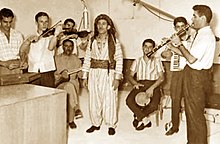
Back موسيقى كردية Arabic Música kurda Catalan مۆسیقای کوردی CKB Kurdische Musik German Música kurda Spanish موسیقی کردی Persian Musique kurde French Muzîka kurdî Kurdish Kürt müziği Turkish
 |
Kurdish music (Sorani Kurdish: میوزیکی کوردی) refers to music performed in the Kurdish languages and Zaza-Gorani languages.[1][2] The earliest study of Kurdish music was initiated by the renowned Armenian priest and composer Komitas in 1903,[3] when he published his work "Chansons kurdes transcrites par le pere Komitas" which consisted of twelve Kurdish melodies which he had collected.[4] The Armenian Karapetê Xaço also preserved many traditional Kurdish melodies throughout the 20th century by recording and performing them.[5] In 1909, Scholar Isya Joseph published the work "Yezidi works" in which he documented the musical practice of the Yazidis including the role of the musician-like qewal figures and the instruments used by the minority.[6]
Kurdish music appeared in phonographs in the late 1920s, when music companies in Baghdad began recording songs performed by Kurdish artists.[7]
Despite being secondary to vocals, Kurds use many instruments in traditional music.[8] Musical instruments include the tembûr (see kurdish tanbur), bağlama, qernête, daf, duduk, kaval, long flute (şimşal),[9] kemenche,[10] oboe (zirne) and drum (dahol).[11]

- ^ Robert F. Reigle (2013). "A brief history of Kurdish music recordings in Turkey". Hellenic Journal of Music Education, and Culture. 4 (2). ISSN 1792-2518.
- ^ Lewkowitz, Joshua (30 May 2019). "Who are the heroes, hustlers and innovators of Kurdish wedding music?". Al-Monitor. Retrieved 18 July 2019.
- ^ Sylvia Angelique Alajaji (2015). Music and the Armenian diaspora : searching for home in exile. Indiana University Press. p. 168. ISBN 978-0253017765.
- ^ Komitas (1903). "Mélodies kurdes recueillies par Archimandrite Comitas" (PDF) (in Armenian). Retrieved 18 July 2019.
- ^ Salih Kevirbirı̂ (2002). Karapetê Xaço: bir çiǧliǧin yüzyili (in Turkish). Sı̂ Yayınları.
- ^ Mohammad Ali Merati (2015). "Les formes fondamentales de la musique kurde d'Iran et d'Irak : hore, siâw-çamane, danses, maqâm" (PDF). Milieux cultures et sociétés du passé et du présent (in French). L'Université Paris Nanterre. Retrieved 19 July 2019.
- ^ Tony Langlois (2011). Non-Western Popular Music. Ashgate: Farnham. ISBN 9780754629849.
- ^ Dorian, Frederick; Duane, Orla; McConnachie, James (1999). World Music: Africa, Europe and the Middle East. Rough Guides. pp. 249. ISBN 9781858286358.
- ^ Alak K. Ardalan (2015). The Black Desert. ISBN 9781504939911.
- ^ Eliot Bates (2016). Digital Tradition: Arrangement and Labor in Istanbul's Recording Studio Culture. p. 289. ISBN 9780190215767.
- ^ Wendelmoet Hamelink (2016). The Sung Home. Narrative, Morality, and the Kurdish Nation. p. 164.